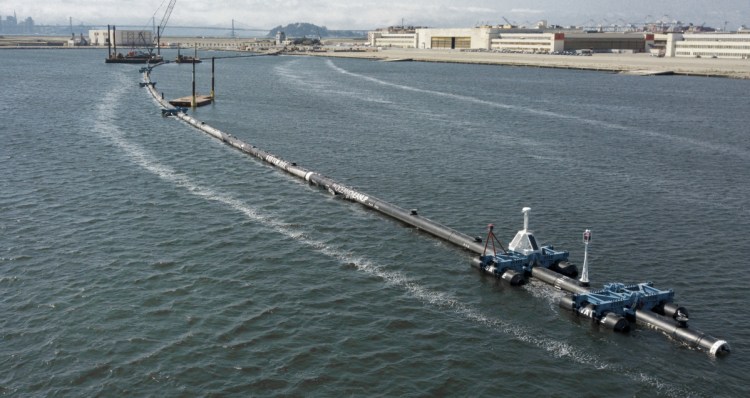SAN FRANCISCO — Engineers will deploy a trash collection device to corral plastic litter floating between California and Hawaii in an attempt to clean up the world’s largest garbage patch in the heart of the Pacific Ocean.
The 2,000-foot-long floating boom will be towed Saturday from San Francisco to the Great Pacific Garbage Patch – an island of trash twice the size of Texas.
The system was created by The Ocean Cleanup, an organization founded by Boyan Slat, a 24-year-old innovator from the Netherlands who first became passionate about cleaning the oceans when he went scuba diving at age 16 in the Mediterranean Sea and saw more plastic bags than fish.

Dutch innovator Boyan Slat, 24, is the founder of The Ocean Cleanup. He said one of the organization’s goals is to remove 50 percent of The Great Pacific Garbage Patch in five years.
“The plastic is really persistent and it doesn’t go away by itself and the time to act is now,” Slat said, adding that researchers with his organization found plastic going back to the 1960s and 1970s bobbing in the patch.
The buoyant, a U-shaped barrier made of plastic with a tapered 10-foot-deep screen, is intended to act like a coastline, trapping some of the 1.8 trillion pieces of plastic that scientists estimate are swirling in that gyre but allowing marine life to safely swim beneath it.
Fitted with solar power lights, cameras, sensors and satellite antennas, the cleanup system will communicate its position at all times, allowing a support vessel to fish out the collected plastic every few months and transport it to dry land where it will be recycled, Slat said.
Shipping containers filled with the fishing nets, plastic bottles, laundry baskets and other plastic refuse scooped up by the system being deployed Saturday are expected to be back on land within a year, he said.
The Ocean Cleanup, which has raised $35 million in donations to fund the project, including from Salesforce.com chief executive Marc Benioff and PayPal co-founder Peter Thiel, will deploy 60 free-floating barriers in the Pacific Ocean by 2020.
“One of our goals is to remove 50 percent of the Great Pacific Garbage Patch in five years,” Slat said.
The free-floating barriers are made to withstand harsh weather conditions and constant wear and tear. They will stay in the water for two decades and in that time collect 90 percent of the trash in the patch, he said. George Leonard, chief scientist of the Ocean Conservancy, a nonprofit environmental advocacy group, said he’s skeptical Slat can achieve that goal because even if plastic trash can be taken out of the ocean, a lot more is pouring in each year.
“We at the Ocean Conservancy are highly skeptical but we hope it works,” he said. “The ocean needs all the help it can get.”
Leonard said 9 million tons of plastic waste enter the ocean annually and that a solution must include a multi-pronged approach, including stopping plastic from reaching the ocean and more education so people reduce consumption of single-use plastic containers and bottles.
“If you don’t stop plastics from flowing into the ocean, it will be a Sisyphean task,” Leonard said, adding that on Sept. 15 about 1 million volunteers around the world will collect trash from beaches and waterways as part of the Ocean Conservancy’s annual International Coastal Cleanup. Volunteers last year collected about 10,000 tons of plastics worldwide over two hours, he said.
Leonard also raised concerns that marine and wildlife could be entangled by the net that will hang below the surface. He said he hopes Slat’s group is transparent with its data and shares information with the public about what happens with the first deployment.
“He has set a very large and lofty goal and we certainly hope it works,” Leonard said.
Send questions/comments to the editors.



Success. Please wait for the page to reload. If the page does not reload within 5 seconds, please refresh the page.
Enter your email and password to access comments.
Hi, to comment on stories you must . This profile is in addition to your subscription and website login.
Already have a commenting profile? .
Invalid username/password.
Please check your email to confirm and complete your registration.
Only subscribers are eligible to post comments. Please subscribe or login first for digital access. Here’s why.
Use the form below to reset your password. When you've submitted your account email, we will send an email with a reset code.